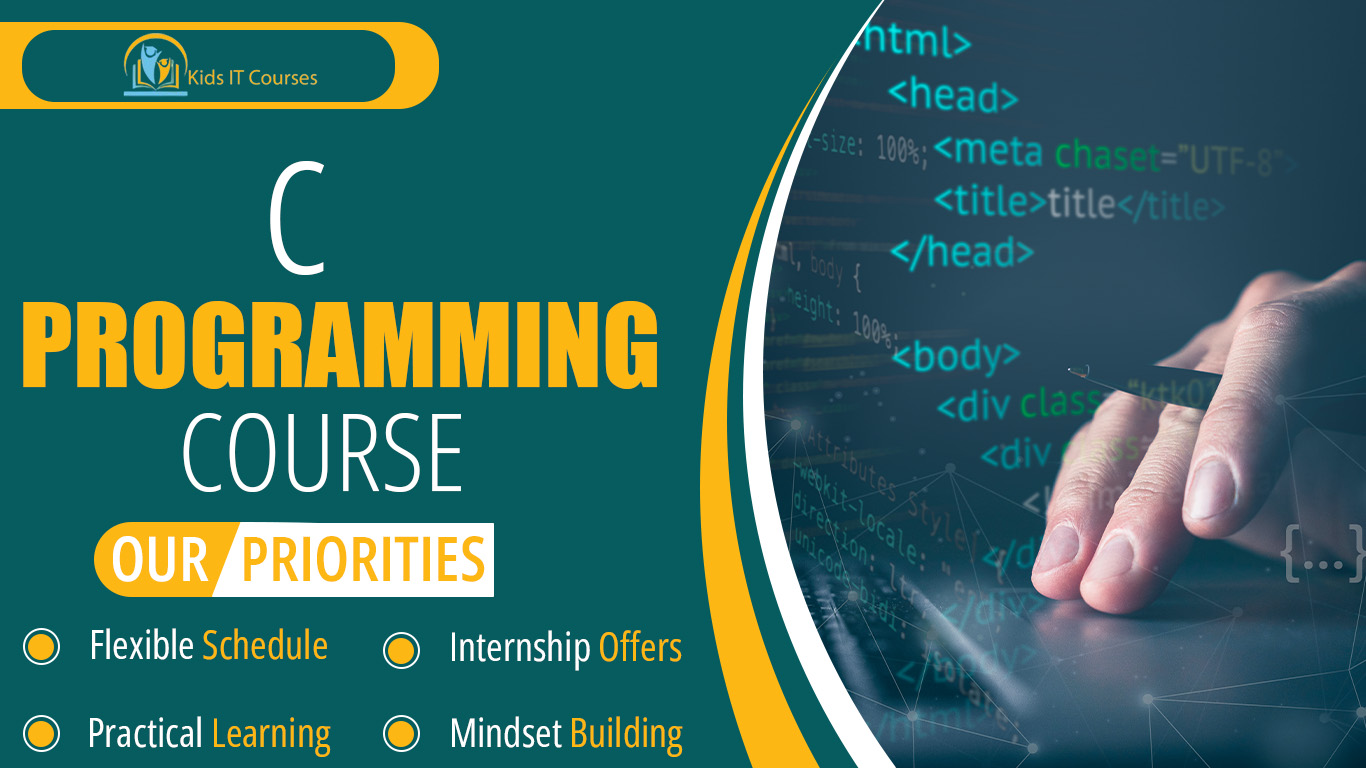
C Programming Course for Kids
Definition
•Kids learn how to write simple computer programs using C language. It’s like learning the ABCs of computer talk!
• C helps kids think in steps and solve problems smartly. It improves their logic and math skills too.
• Writing code needs attention and fixing small errors. This teaches kids to stay focused and not give up easily.
• Kids use simple software to write, test, and run C programs. They get real experience with coding tools.
• They can build small games, calculators, or fun apps. It makes learning C exciting and rewarding.
• Solving coding challenges gives kids a big confidence boost. They feel proud when their code works!
• C is a strong base for learning other languages like C++, Python, or Java. Starting early gives kids a head start in tech careers.
Importance
• Kids learn how computers understand instructions using C language. It’s like teaching the computer how to think and work.
• They solve problems by breaking them into smaller steps. It improves their brainpower and sharp thinking.
• C is used in games, apps, and systems. Kids get to see how things really work inside machines.
• They use simple math in coding tasks. It helps them get better at solving real-life challenges.
• Kids can make fun mini projects like quizzes or timers. It keeps learning fun and exciting.
•C is a powerful language that helps kids learn other coding languages easily. It’s a great first step into the tech world.
•C is used in robotics, apps, and even space tech! Learning it now gives kids a big head start.
Advantages for Freelancing
• Kids learn how to write simple commands using C language. It helps them understand how computers follow instructions.
• C programming teaches kids to think step by step. It sharpens their brain and problem-solving skills.
• C is the base of many other languages like C++, Java, and Python. Learning it makes it easier to learn more coding later.
• Writing code helps kids get better at counting, patterns, and logic. It’s like doing fun puzzles with numbers.
• Coding in C needs careful attention and planning. Kids learn to stay focused and not give up.
• They see how programs and games are made behind the scenes. It makes technology more fun and easy to understand.
• C is used in real-life systems like robots, machines, and apps. Learning it early opens doors to great future jobs.
Session 1 : What is C Programming?
What is C and why is it important?
Simple explanation: the building blocks of many modern programs
Real-life example: C is like LEGO bricks used to build big systems
Why C is powerful: fast, light, and close to how computers “think”
Where C is used: video games, robots, phones, operating systems
Fun comparison: C vs. Scratch (like real tools vs. toy tools)
Activity: Write your first C program –
Hello, World!
Session 2 : Variables – Storing Information
What are variables? (Tiny storage boxes with names)
Real-life example: labeling your school supplies
Data types in C: int, float, char (numbers, decimals, letters)
How to create and use variables in C
Activity: Create a mini calculator using variables
Visual activity: draw a box for each variable in memory
Session 3 : Input & Output – Talking to the Computer
What is input and output in C?
Real-life example: asking a question and getting an answer
Using
scanf()to take user inputUsing
printf()to display resultsActivity: create a program that asks for your name and age
Fun twist: build a mini quiz using input/output
Session 4 : Decisions with If-Else – Making Choices
What is an if-else statement?
Real-life example: If it rains, use an umbrella; else, wear sunglasses!
Why computers need logic to make decisions
Comparison operators:
>,<,==,!=Activity: create a program that gives a grade based on a score
Visual activity: draw a decision tree for a simple situation
Session 5 : Loops – Repeating Like a Robot
What are loops and why they’re helpful
Real-life example: brushing your teeth every morning
for,while, anddo whileloops explained simplyHow loops save time and reduce repetition
Activity: print your name 10 times using a loop
Challenge: build a countdown timer using a loop
Session 6 : Arrays – A Group of Variables
What is an array?
Real-life example: a row of mailboxes, each with a number
How arrays help store and organize multiple values
Accessing elements using indexes
Activity: store and print 5 favorite numbers
Fun task: find the biggest number in an array
Session 7 : Functions – Breaking Code into Pieces
What is a function and why use them?
Real-life example: following a recipe in a cookbook
How to write and call functions in C
Activity: create a function that multiplies two numbers
Bonus: learn about
main()– the boss function!Why functions help build bigger programs easily
Session 8 : C in Real Life & Your Coding Journey
Where is C used in real life: video games, space tech, robots
Real-life example: C is like a language robots and machines understand best
What’s next after learning C? (C++, embedded systems, game development)
Activity: design your dream project using C
Fun drawing: build a robot and imagine how C would control it
Why learning C makes you a stronger programmer
Bonus Materials:
Interactive coding quizzes and logic games
Beginner-friendly tools: Replit, OnlineGDB, CodeBlocks
Printable C syntax and commands sheet
Team project: Build a “Guess the Number” game in C
Official Certificate of Completion
